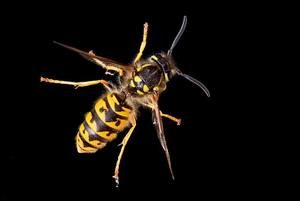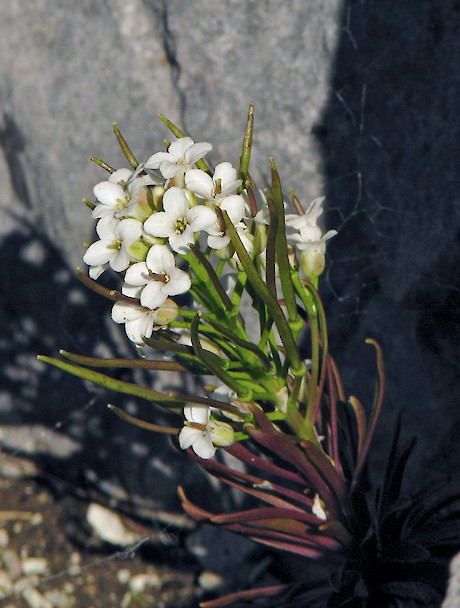 German wasp (Vespula germanica). Photo: Bernie KohlThere are many species of insect pest in New Zealand. They include species that affect the New Zealand economy such as the gypsy moth and the varroa mite and species that affect our indigenous biodiversity. Some examples are provided here:
German wasp (Vespula germanica). Photo: Bernie KohlThere are many species of insect pest in New Zealand. They include species that affect the New Zealand economy such as the gypsy moth and the varroa mite and species that affect our indigenous biodiversity. Some examples are provided here:
Wasps
Four pest wasp species have been accidentally introduced to New Zealand. They are the Asian paper wasp, the Australian paper wasp and the German and common wasps. The German wasp was introduced with US aeroplane parts in the 1940s and the common wasp arrived only recently but is already widespread.
New Zealand has some of the highest densities of common and German wasps in the world since they have no natural predators here. They are especially problematic in beech forests where they consume honeydew which is produced by a native scale insect and is an important food for native birds, bats, insects and lizards. Wasps also prey on insects and have even been seen killing newly-hatched birds.
For more information go to:
- Wasp numbers in honeydew forest (Landcare Research)
Argentine ant
Argentine ants (Linepithema humile) are one of the worlds most invasive and problematic ant species. They are aggressive and although they are not poisonous, they do bite people. Argentine ant colonies co-operate with each other and, over winter, can combine over winter into super-colonies. Argentine ants are small (2-3 mm long) and honey-brown in colour, while most other common household ants in New Zealand are black.
Argentine ants are highly active in searching for food and their trails are often five or more ants wide. Unlike most other ants, they climb trees to get to food sources. Argentine ants can have a massive impact on the natural environment. These threats include eliminating other species of ants, competing with birds and lizards for food such as insects and worms and displacing and killing native invertebrates. They are known from parts of Auckland and Northland, as well as Bay of Plenty, Hawkes Bay, Wellington, Nelson and Christchurch.
Great white butterfly
The great white butterfly (Pieris brassicae) was recorded in New Zealand in 2010 and poses a threat to species in the Brassica Family.
The Department of Conservation has been responsible for managing the Great White Butterfly Eradication Programme since 2012. The department became involved in the incursion response out of concern for some of New Zealand’s 79 native cress species (nearly 3% of New Zealand’s indigenous vascular flora) of which 55 are currently classified as Threatened or At Risk (de Lange et al., 2013). A further 13 are not currently threatened but are nonetheless at risk from P. brassicae. Unlike P. rapae which lays single eggs, P. brassicae lays eggs in batches of 50 - 150. The caterpillars feed in groups on a wide range of host plants, and will completely defoliate a plant before movning up to 100m in search of more plants.
 Pachycladon fasciarium. Photo: Jan Clayton-GreeneTwo examples of nationally critical plants that are particularly vulnerable due to their small populations and proximity to the infestation zone are coastal peppercress and Pachycladon fasciarium. Coastal peppercress (Lepidium banksii), related to Cook’s scurvy grass, with less than 150 known individuals is confined to several sites in Tasman Bay. Pachycladon fasciarium is rarer than kākāpō with only 37 known individuals. This cress is confined to the limestone bluffs of the Chalk Range, South Marlborough.
Pachycladon fasciarium. Photo: Jan Clayton-GreeneTwo examples of nationally critical plants that are particularly vulnerable due to their small populations and proximity to the infestation zone are coastal peppercress and Pachycladon fasciarium. Coastal peppercress (Lepidium banksii), related to Cook’s scurvy grass, with less than 150 known individuals is confined to several sites in Tasman Bay. Pachycladon fasciarium is rarer than kākāpō with only 37 known individuals. This cress is confined to the limestone bluffs of the Chalk Range, South Marlborough.
The eradication programme is a world first attempt to eradicate a butterfly and is progressing well with an encouraging decline in P. brassicae detections. Comparing monthly detections between years gives a good indication of the declining population. In November 2013 the team detected made 227 great white butterfly detections compared with 12 in November 2014. There were similar results for the month of December where 220 detections in December 2013 dropped to just 1 in December 2014. The eradication team remains positive whilst anticipating a small increase in number of detections as P. brassicae emerge from aestivation this autumn.
For more information go to:
- Great white butterfly (Department of Conservation
- P.J. de Lange; J. Rolfe; P. Champion; S. Courtney; P.B. Heenan; J. Barkla; E. Cameron; D. Norton; R. Hitchmough (2013). Conservation status of New Zealand indigenous vascular plants, 2012. New Zealand Threat Classification Series (Web) no.3. Department of Conservation (PDF, 792.88 kB)
